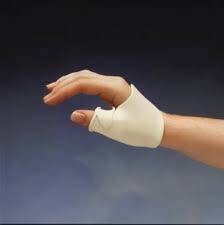Splinting
As part of our hand therapy services we also offer Splinting. Splinting plays an important role in rehabilitation of many hand conditions and its functions is either:
- restriction of movement, protecting and supporting healing bones, ligaments, tendons or skin after surgery or injury , e.g. tendon or ligaments repair, grafting over joints, mallet finger, after burns or crush injury
- immobilisation for pain relief - stopping painful joints from moving, e.g. during flare up of rheumatoid arthritis
- supporting malfunctioning structure to improve the function, e.g. improving grip with thumb arthritis, improving grasp with claw hand after nerve injury
- mobilisation - splints made specifically to lengthen the correct tissues in damaged hand to increase range of movement safely and gradually after injury, e.g. serial splinting for stiff PIP (middle knuckle) joint, exercise splint after mallet finger injury, after Dupuytren's surgery
In our clinic we use different thermoplastic materials to make a tailored splint fitting your hand/wrist. The thermoplastic splinting material is a special type of plastic that becomes soft and flexible when heated and can be moulded into your hand and wrist; it hardens again as it cools down and maintains the shape it was moulded into. The splinting process starts with making a paper pattern and trying the fit on your hand. This is then transferred to the thermoplastic material, cut out and heated to make it soft and pliable. The warm splint is then moulded to your hand /wrist in the desired position and we wait until it cools down. Soft strapping is attached to the splint to keep it stable on the hand and to apply additional forces over areas as needed. Further adjustments are then made to make sure the splint fits perfectly and doesn't cause discomfort, you will be also given information on what to watch for to prevent any adverse effects of the splint and on how to care for the splint.
If you experience any of the adverse effects it is very important to contact me immediately so the splint can be reviewed and readjusted as needed.
splinting after hand or wrist surgery
Splinting is a crucial part of treatment after many hand and wrist surgeries, e.g. tendon repairs, nerve repairs, Dupuytren's surgery, mallet finger repair, sometimes after K-wire insertion (to protect the protruding wire), after joint replacements / arthroplasty, trapeziectomy, certain fractures, crash injuries, after DeQuervain's tendonitis surgery, after large grafting over joints. The splint provides support and protection for the healing structures. It often replaces the heavy cast or bulky bandaging that is usually applied straight after the surgery. You will be sent for splinting by your surgeon usually after the first post-operation review and re-dressing. The first splint can be sometimes applied over protective bandaging or over hand that is swollen. As the bandaging is reduced and as your swelling comes down the splint might need readjusting to ensure snug fitting.
Splinting for pain relief
Resting splint is useful device to ease the pain caused by acute inflammation during flare-up of rheumatoid arthritis. The hand and wrist are placed in the position of rest that allows for the joints and tendons to be in an optimal position to decrease irritation and inflammation. It helps to decrease the pain and swelling.
Splinting to improve function
The splints in this category are designed to support affected joints in position that allows for better use of the hand. For some of the conditions there are off-the shelf supports and splints - for example there are many comfortable and supportive thumb and wrist splints for arthritic hand conditions, but if the joint has deformity you may need to have a fitted splint made. Placing the thumb or wrist in optimal position will allow for the muscles and tendons to work more efficiently without excessive strain and enable better grip, pinch and overall function.
Other conditions requiring splinting to improve function are neurological conditions like cerebral palsy or stroke, nerve damage due to illness or injury - ulnar nerve lesion, radial nerve lesion and sometimes median nerve lesion. The joints are again held by the splint in more optimal position to allow for the unaffected structures to work more efficiently.
Splinting for mobilisation of joints and soft tissue
Mobilisation splints are used to:
- improve pliability and length of soft tissues of the hand and wrist: muscles, tendons, ligaments, joint capsule, skin and scars
- improve passive range of movement in the joint
- maintain the range of movement achieved during the treatment session









